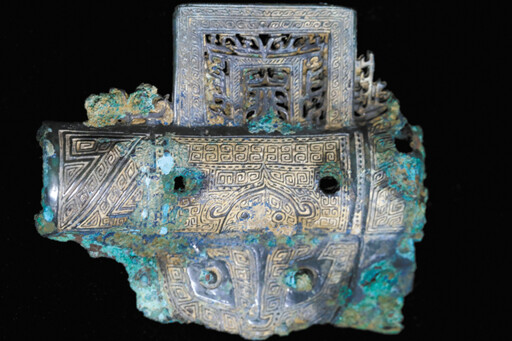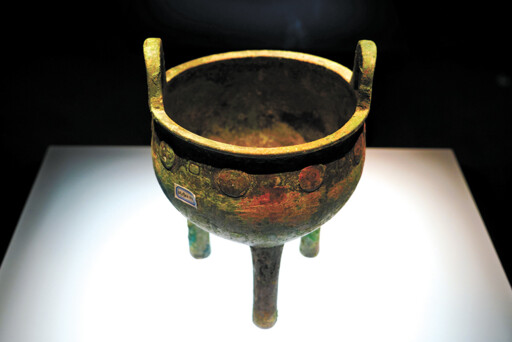


Radiocarbon dating refines chronology of China’s early dynasties

A bronze vessel unearthed at the Liulihe site in Beijing Photo: IC PHOTO

The “Zuoce Huan” ding (ritual tripod vessel) displayed in the Grand Canal Museum of Beijing Photo: IC PHOTO
Time is one of the most fundamental dimensions in archaeological research, and precise chronological determination is the prerequisite for constructing sound and credible historical narratives. Since the launch of the “Xia-Shang-Zhou Chronology Project,” radiocarbon dating—also known as carbon dating or carbon-14 dating—has become closely integrated with archaeological and historical studies of the Xia (c. 21st–16th century BCE), Shang (c. 16th–11th century BCE), and Zhou (c. 11th century–256 BCE) dynasties. Researchers have accumulated a large body of direct dating data from archaeological sites, attempted to align archaeological cultural sequences with radiocarbon results, and discussed the timing of key historical events based on specific archaeological layers. These efforts have demonstrated the effectiveness of radiocarbon dating and multidisciplinary collaboration in chronological research.
Absolute dating is ‘relative’
The “absolute dates” derived from radiocarbon measurements are, in fact, “relative.” This limitation arises mainly from two aspects.
First, there is often a mismatch between the physical age of a sample and the timing of the target event under investigation. In archaeology, radiocarbon dating commonly uses materials such as charcoal, bone, and plant seeds. Yet the radiocarbon age obtained, the corresponding calibrated calendar age, the formation time of the archaeological context from which the sample was collected, and the date of the associated archaeological or historical event do not always coincide. For example, when archaeologists attempt to determine when a tomb owner was buried, when a building was repaired, or when a city was founded, radiocarbon results from individual samples often cannot directly answer these questions.
Second, the level of precision in radiocarbon dating is often insufficient for addressing historical and archaeological questions concerning the three early dynasties. As physical measurements, radiocarbon ages carry inherent errors, and after calibration the resulting calendar ranges are often broadened. Under the standard 95.4% confidence interval, the calibrated range may exceed a century, meaning that calendar ages obtained from single-sample calibration are generally inadequate for meaningful historical interpretation.
Achieving high-precision dating using radiocarbon methods requires selecting samples with clear chronological significance and a definite association with the human activity or historical event under study. It also requires a series of interrelated samples with known temporal relationships. Through Bayesian statistical modeling, such sample series can yield more precise chronological results. This approach depends on suitable dating materials, careful research design, and close coordination between fieldwork and laboratory procedures.
Dating human bone series samples
To meet the growing need for highly accurate dating in archaeology, researchers have introduced new and innovative techniques. One important advancement is the “human bone series samples” method, which uses multiple samples from different bone tissues of the same individual to achieve greater chronological precision.
Tombs are a crucial category of archaeological remains, and because the human body belongs to the tomb owner, its biological characteristics make high-precision dating possible. Human teeth develop during childhood and adolescence and remain largely unchanged thereafter, while tissues such as limb bones and ribs undergo continuous metabolic renewal. These tissues record the average radiocarbon signature across longer spans of an individual’s life, and different bone types have different metabolic rates. This physiological variation allows researchers to extract multiple samples from the same individual to construct a chronological “series” for radiocarbon dating. After Bayesian statistical analysis, this approach produces more refined results—operating on principles analogous to “tree-ring series” dating.
By dating different teeth and bone tissues from the same individual and incorporating the differences in the time periods represented by these tissues, researchers can encode the chronological sequence and time intervals among the samples as prior information in a Bayesian model. This yields calendar age ranges with much higher precision than a single bone sample could provide. More importantly, when combined with estimates of the individual’s age at death, the model can directly determine a probable time range for death, producing a chronological conclusion closely aligned with historical interpretation.
This method has been successfully applied in dating the noble tomb M1902 at the Liulihe site in Fangshan District, Beijing. Liulihe was the capital site of the Yan state during the Western Zhou Dynasty, and the excavation of M1902 was one of the major findings in recent fieldwork there. Bronze inscriptions found in the tomb record the historical event of “the Grand Guardian the Duke of Shao building the capital city of Yan” in the early Western Zhou period, marking the origins of both the Yan state and the city of Beijing. The tomb owner, Zuoce Huan, personally witnessed this event. According to the inscriptions, he served as an official historian of Yan, participated in constructing the city wall and the associated ceremonies, and recorded his experiences on bronze vessels that accompanied him into the afterlife. Through radiocarbon dating and statistical analysis of tooth sections and multiple bone tissues from the same individual, researchers determined that the most probable time range of his death was between 1045 and 1010 BCE, indicating the date when the tomb was built. Within the same tomb, dating results from the bones of sacrificial dogs and sheep, bamboo fragments from inside bronze containers, and planks from different parts of the coffin all corroborated this finding.
The advancement of archaeometric research continues to enrich our understanding of daily life during the three dynasties, and high-precision dating provides a more accurate temporal framework for such insights. The multidisciplinary study of M1902 is a typical case. Using precise chronological data supported by field archaeology and multidisciplinary analysis, researchers have reconstructed the life history of the first generation of Yan “migrants.” After the Zhou conquest of the Shang, Zuoce Huan moved from the former Shang territory to the northern frontier of the Zhou realm, where he was appointed as an official historian and played an active role in local governance. His distinctive dietary and funerary practices were respected by the locals, and his tomb was situated alongside those of the Zhou people.
Deepening chronological studies of the three dynasties
In recent years, radiocarbon dating in archaeology has advanced toward greater refinement, incorporating a wider range of sample types, smaller sample sizes, more rigorous assessments of sample preservation, and improved calibration curves. Against this backdrop, the “human bone series samples” method, guided by clearly defined research questions and supported by contextual archaeological data, enables a more nuanced interpretation of the temporal information embedded in samples. Applying this method to significant burials is expected to further refine the dating of major historical time points, cultural periodization, and other chronological issues concerning the Xia, Shang, and Zhou dynasties.
First, it enables precise identification of key dates. Determining the foundation, occupation, and abandonment dates of capital sites, as well as pinpointing the timing of dynastic transitions, remains a central task in Xia-Shang-Zhou chronology.
Second, it contributes to refining the archaeological cultural chronology of the three dynasties. Cultural periodization and lineage studies form the foundation of Xia-Shang-Zhou archaeology. Although a general absolute chronological framework has been established—primarily based on major capital sites—it still requires refinement through more detailed material comparisons and dating efforts. Tombs, as typical “time capsules,” offer a crucial entry point for such high-precision chronological research. Precise dating of tombs can deepen understanding on two levels. Comparing the dates of different tombs within the same cemetery alongside changes in burial pottery and other artifacts allows for direct observation of the rate of artifact change reflected in typology. Meanwhile, systematic studies of burials from different regions within the same cultural period make it possible to assess the synchronicity of archaeological cultural development across regions.
Finally, beyond locating key time points and refining cultural chronology, higher-precision dating allows for more dynamic and multidimensional observation of historical processes such as goods exchange, migration, and political transformation. Taking the Western Zhou period as an example, clarifying how the new dynasty established political order in conquered territories is a major question raised by recent archaeological discoveries. After the Zhou conquest of the Shang, large-scale enfeoffment was carried out in newly acquired territories during the reigns of kings Wu and Cheng. While transmitted and excavated texts outline this process in broad terms, many details remain unclear. Archaeologically, the widespread appearance of Zhou cultural remains in the eastern regions during the early Western Zhou largely confirms the geographical scope of Zhou enfeoffments. Yet several questions remain: Did these remains appear as early as the very beginning of the Western Zhou? What was the situation in western regions not covered by written records? And did the timing of Zhou expansion and political control differ among regions or among sites within the same region? Addressing these questions requires fine-grained and systematic chronological research centered on clearly identified Western Zhou remains across multiple locations.
As archaeological data continues to accumulate and techniques advance, new questions inevitably emerge. Chronology—serving as both anchor and thread—plays an increasingly fundamental role in archaeological inquiry. Continued reflection and methodological innovation in practice will remain essential in the future.
Ouyang Xinyi, Lin Yixian (engineer), and Wu Xiaohong (professor) are from the School of Archaeology and Museology at Peking University.
Copyright©2023 CSSN All Rights Reserved